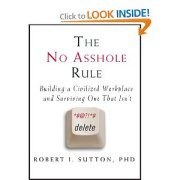The No [Censored] Rule
The No [Censored] Rule
By Robert Sutton, Ph.D.
Note: To avoid triggering filters, I’m substituting the word “jerk” for the censored word in the title. You can see the original in the image.
Dr. Robert I. Sutton is a champion of the civilized workplace, created and maintained through careful enforcement of the no “jerk” rule. Expanding and deepending his 2004 Harvard Business Review article entitled “More Trouble Then They’re Worth,” Sutton’s 2007 book The No [Censored] Rule offers valuable tips for eliminating or avoiding nasty people in business. As its tag line promises, this truly is “the definitive guide to working with — and surviving — workplace bullies, creeps, jerks, tyrants, tormentors, despots, and egomaniacs.”
In less than 200 entertaining pages, Sutton explains how to identify a workplace jerk (even how to tell if you’re the jerk) and describes the damage these jerks wreak on the organizations in which they work and the clients and colleagues with whom they come into contact. He also addresses how to handle a workplace jerk, while warning of the dangers of “jerk poisoning.” According to Sutton, a jerk is one who oppresses, humiliates, de-energizes, or belittles his target (generally someone less powerful than himself), causing the target to feel worse about herself following an interaction with the jerk. (And, as his numerous examples prove, this behavior is not by any means limited to male perpetrators or female victims.)
These jerks use tactics such as personal insults, sarcasm and teasing as vehicles for insults, shaming, and treating people as if they’re invisible to deman others. This behavior is sometimes hard to distinguish from routine bad behavior, but (like obscenity) you’re likely to know it when you see it. Sutton distinguishes temporary jerks (because, as he notes, we all have the potential to act like jerks at times, particularly when we’re stressed) from certified jerks, who routinely show themselves to be nasty people. The latter, he argues, must go. He also carefully distinguishes constructive, even noisy, arguments about ideas from behavior that descends into a nasty personal attack and disavows any hint that spineless or obsequious people are the preferred alternative to jerks.
Having diagnosed the problem, Sutton then recommends how to implement and enforce a “no jerk rule,” how a jerk may reform himself/herself, and how to survive working in nasty environments or with nasty people. Survival mechanisms include looking for small wins that allow you to sustain (or regain) confidence and a sense of control, reframing the situation and detaching from it, limiting exposure to the jerk, building situations of “safety, support, and sanity,” fighting and winning the right small battles, and leaving the job that’s put you in contact with the jerk.
Sutton also discusses the dangerous topic of the benefits of the jerk’s behavior, such as motivating fear-driven performance and perfectionism. Though he is careful to note that these benefits don’t justify bad behavior, the “virtues of nastiness” are as real as the damage nastiness causes. Sutton includes five key tips for those who want to be effective jerks, while noting that even these tips are inherently dangerous:
- Expressing anger, even nastiness, can be an effective method for grabbing and keeping power.
- Nastiness and intimidation are especially effective for vanquishing competitors.
- If you demean your people to motivate them, alternate it with (at least occasional) encouragement and praise.
- Create a “toxic tandem” with someone who will play good cop to your bad cop.
- Being all jerk, all the time, won’t work.
Although the jerk partner (or senior associate or paralegal or…) is, unfortunately, almost an archetype in law firm life, it’s just as important to identify nasty clients — or better yet, nasty potential clients. Those are the clients who will demand and demean, who will push good lawyers to make bad arguments, who will cause their lawyers untold stress. Lawyers must know when to refuse a case, and evaluating the cost of representing a jerk is a critical underlying skill. Check this previous blog post for tips on identifying red flags for potentially difficult or nasty clients.




Leave a Reply
Want to join the discussion?Feel free to contribute!